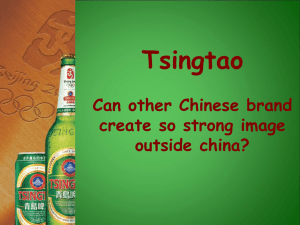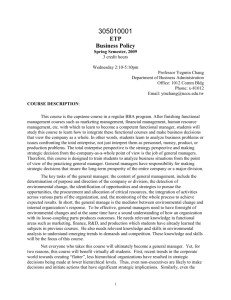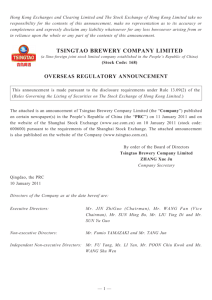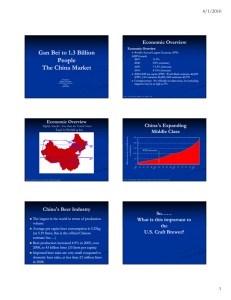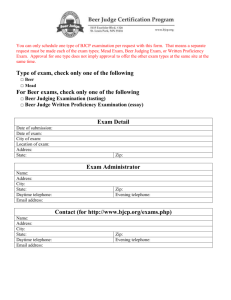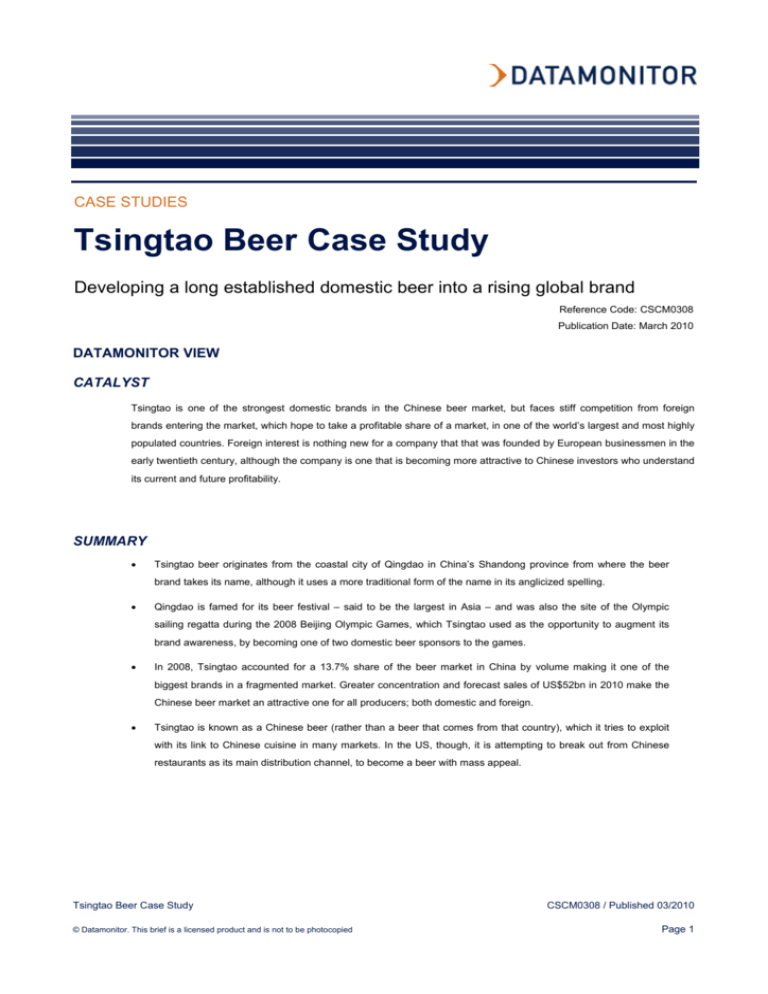
CASE STUDIES
Tsingtao Beer Case Study
Developing a long established domestic beer into a rising global brand
Reference Code: CSCM0308
Publication Date: March 2010
DATAMONITOR VIEW
CATALYST
Tsingtao is one of the strongest domestic brands in the Chinese beer market, but faces stiff competition from foreign
brands entering the market, which hope to take a profitable share of a market, in one of the world’s largest and most highly
populated countries. Foreign interest is nothing new for a company that that was founded by European businessmen in the
early twentieth century, although the company is one that is becoming more attractive to Chinese investors who understand
its current and future profitability.
SUMMARY
•
Tsingtao beer originates from the coastal city of Qingdao in China’s Shandong province from where the beer
brand takes its name, although it uses a more traditional form of the name in its anglicized spelling.
•
Qingdao is famed for its beer festival – said to be the largest in Asia – and was also the site of the Olympic
sailing regatta during the 2008 Beijing Olympic Games, which Tsingtao used as the opportunity to augment its
brand awareness, by becoming one of two domestic beer sponsors to the games.
•
In 2008, Tsingtao accounted for a 13.7% share of the beer market in China by volume making it one of the
biggest brands in a fragmented market. Greater concentration and forecast sales of US$52bn in 2010 make the
Chinese beer market an attractive one for all producers; both domestic and foreign.
•
Tsingtao is known as a Chinese beer (rather than a beer that comes from that country), which it tries to exploit
with its link to Chinese cuisine in many markets. In the US, though, it is attempting to break out from Chinese
restaurants as its main distribution channel, to become a beer with mass appeal.
Tsingtao Beer Case Study
© Datamonitor. This brief is a licensed product and is not to be photocopied
CSCM0308 / Published 03/2010
Page 1
Tsingtao Beer Case Study
ANALYSIS
Introduction
Tsingtao (pronounced “Ching Dow”,) is a golden lager beer that was first brewed in 1903 by the Tsingtao brewery, which
also oversaw its own bottling operations. Tsingtao describes its flagship beer as a crisp lager with, “a malty flavor and nutty
sweet taste, which complements spicy or flavorful Asian cuisine”. It is brewed for 52 days and is made with imported barley
sourced from Canada, France and Australia: the last of these countries is also the source of the yeast used in brewing.
Hops from the west of China along with domestically-grown rice are also added to the recipe (which means the beer falls
foul of the Rheinheitsgebot purity laws present in the German beer market, which stipulates that only water, hops, malted
barley and yeast may be used in the brewing of beer). However, in its favor, in relation to purity, Tsingtao uses spring water
from the Laoshan mountain region of China and includes no artificial preservatives, so it is said to have no chemical aftertaste.
The coastal city of Qingdao (which has changed its anglicized spelling from Tsingtao), is located in Shandong province in
southeastern China. For many centuries it was a small town with its most prominent landmark being the eight-sided pavilion
at the end of a 440 meter pier. This pavilion is still said to be Qingdao’s most famous present day landmark and forms part
of the label logo of Tsingtao beer. The city of Qingdao played host to the sailing regatta of the 2008 Summer Olympic
Games in China. The Tsingtao brand used this opportunity to become one of the official domestic beer sponsors of the
Olympics.
Figure 1:
The Beijing Olympics of 2008 were a key opportunity for all Chinese brands
Tsingtao was one of three beers
to sponsor the 2008 Olympics. It
make much of the association by
subjugating its own logo to that
of the Beijing games.
Source: Datamonitor analysis
DATAMONITOR
The Tsingtao beer brand was developed in 1903 by German and British expatriate businessmen who founded the Nordic
Brewery Co Ltd (Tsingtao Branch) with an investment of around US$65,000. The link to Germany is explained by the taking
of Qingdao by force in 1897 by the troops of Kaiser Wilhelm at a time when European colonial forces were displaying great
th
interest in China and the Far East. Under the control of colonial forces until the second decade of the 20 century, Qingdao
grew into a bustling seaport (the fourth most important in China) with its population reaching 275,000 (compared with the
present day seven million). In 1915 the British interests in the business were bought out and the German share confiscated
with Japanese business taking control until 1945. After this time the company reverted to Chinese ownership.
Tsingtao Beer Case Study
© Datamonitor. This brief is a licensed product and is not to be photocopied
CSCM0308 / Published 03/2010
Page 2
Tsingtao Beer Case Study
The Tsingtao company states that its product is the number one consumer product exported from China. Datamonitor
believes this refers to domestically-owned and produced products rather than those foreign-owned brands whose products
are manufactured/assembled in China. The company now has around 50 production sites and employs 5,000 people in
total.
The beer market in China offers much potential
In China, beer is the most popular alcoholic drink consumed in terms of value spend (see Table 1). Beer is also the fastestgrowing drink with double digit both recorded and forecast. At present, the sales of other alcoholic drinks in China are
dwarfed by comparison, with spirits achieving one quarter of beer’s sales. However, grain-based local spirits are popular in
China with consumers of various income levels; nonetheless, despite the high volume consumed in times of celebration,,
the overall volume consumed annually and its commercial value is low. Many grain-based spirits are not marketed as
consumer packaged goods in the western sense, although this will inevitably change as China develops further with its
continuing growth as a global economic superpower.
One other change to the alcoholic drinks market in China is that wine is also likely to become more popular. The rise in
disposable income among China’s urban affluent consumers is likely to be accompanied by a surge of interest in
connoisseurship-driven consumption, which would benefit premium spirits to some degree. However, wine is more likely to
benefit, as there are few other consumer categories in which connoisseurship is as important as in the wine market.
Therefore, it is unsurprising that wine sales are expected to grow in China in future.
Table 1:
Category
Alcoholic drinks market Value (US$ m) by category, China 2005-15
2005
2010
2015
CAGR 2005-10
CAGR 2010-15
29,572.6
52,131.9
79,995.6
12.0%
12.2%
Spirits
9,251.5
13,061.4
17,048.0
7.1%
7.3%
Wine
5,245.5
6,778.3
8,563.9
5.3%
5.2%
44,069.6
71,971.6
105,607.4
10.3%
10.5%
Beer
Overall
Source: Datamonitor Market Data Analytics (MDA) Database
Tsingtao Beer Case Study
© Datamonitor. This brief is a licensed product and is not to be photocopied
DATAMONITOR
CSCM0308 / Published 03/2010
Page 3
Tsingtao Beer Case Study
However, the promise of premiumization and growth for premium spirits and wine is still some way off in China. At present
beer is the number one alcoholic drink, and by some margin. The types of beer sold today in China are fairly homogenous,
with lager types dominating (see Table 2). Indeed, this is the case in many beer markets across the world, as consumer
tastes have evolved to the benefit of lagers rather than heavier and more robust ales and bitters. It should be little surprise
that lagers are popular given that Tsingtao itself has always been brewed like a German Pilsner and has done much to
establish this preference in the Chinese market.
Table 2:
Beer market value (US$ m) by type, China, 2005-15
Segment
2005
2010
2015
CAGR 2005-10
Standard lager
23,698.7
42,283.2
64,012.0
12.3%
12.5%
Premium lager
5,629.9
9,415.1
15,253.9
10.8%
10.7%
Low/no alcohol
77.4
147.7
266.3
13.8%
13.6%
Specialty beer
96.5
157.2
246.6
10.3%
10.1%
Ales, stouts & bitters
Overall
CAGR 2010-15
70.1
128.7
229.4
12.9%
12.7%
29,572.6
52,131.9
79,995.6
12.0%
12.2%
Source: Datamonitor Market Data Analytics (MDA) Database
DATAMONITOR
Table 3 shows that Tsingtao’s share of the beer market reached double figures in 2008, but has been in decline in recent
years, as foreign producers increase the overall level of competition. However, during the last half of the decade or so,
Yanjing beer from Beijing has been strengthening its position. Tsingtao’s own market share figures and those of other
industry commentators suggest that its share has increased marginally since 2008. The fluidity of the market is
demonstrated by the changes in share for different companies, as they change their own names and internal ownership
structures and divest their interests to other rivals for various reasons. The biggest threat to Tsingtao at present is posed by
the large global producers such as (the recently formed) Anheuser Busch InBev, Molson Coors and SAB Miller. The
presence of these companies is testimony to the attractiveness of the beer market in China.
Tsingtao Beer Case Study
© Datamonitor. This brief is a licensed product and is not to be photocopied
CSCM0308 / Published 03/2010
Page 4
Tsingtao Beer Case Study
Table 3:
Beer market volume by company share, China, 2003-08
Company
2003
2004
2005
2006
2007
2008
Anheuser-Busch Companies, Inc.
3.0%
7.2%
8.6%
9.2%
10.3%
0.1%
Anheuser-Busch InBev
0.1%
0.1%
0.1%
0.1%
0.1%
24.0%
Asahi Breweries, Ltd.
1.4%
1.4%
1.5%
1.5%
1.6%
1.6%
Beijing Chaori Beer Co.,Ltd
0.7%
0.8%
0.8%
0.8%
0.8%
0.9%
Beijing Yanjing Beer Group
8.8%
9.2%
9.4%
9.9%
10.2%
10.5%
Brauerei C. & A. VELTINS GmbH & Co
1.0%
1.1%
1.1%
1.1%
1.2%
1.2%
Carlsberg A/S
1.9%
2.0%
2.1%
2.1%
2.2%
2.3%
Harbin Beer Group Co., Ltd.
3.8%
0.1%
0.1%
0.1%
0.1%
0.1%
InBev
0.1%
0.1%
6.7%
11.4%
12.5%
0.1%
Interbrew S.A.
5.9%
6.1%
0.1%
0.1%
0.1%
0.1%
Kirin Brewery Holdings Company, Limited
Molson Coors Brewing Company
Pabst Brewing Company
SABMiller
San Miguel Corporation
1.9%
2.0%
2.0%
2.1%
2.2%
2.2%
11.9%
12.1%
12.3%
12.5%
12.7%
12.9%
0.3%
0.4%
0.4%
0.4%
0.4%
0.4%
10.5%
11.2%
13.5%
15.6%
15.7%
15.9%
2.0%
2.0%
2.2%
2.5%
2.5%
2.7%
Shanghai Asia Pacific Brewery Co., Ltd.
7.6%
7.8%
8.0%
8.3%
8.5%
8.8%
Suntory Limited
1.2%
1.2%
1.3%
1.3%
1.4%
1.4%
Tsingtao Brewery Company Limited
16.7%
16.2%
15.9%
14.5%
14.3%
13.7%
Other
21.4%
19.4%
14.2%
6.9%
3.7%
1.7%
100.0%
100.0%
100.0%
100.0%
100.0%
100.0%
Overall
Source: Datamonitor Market Data Analytics (MDA) Database
DATAMONITOR
The ownership of Tsingtao has been varied in recent years
In 1993, Tsingtao became the first Chinese company to list its shares on the Hong Kong stock market (with the issue of
317.6 million ‘H’ shares at HK$2.80 per share, raising HK$900 million in the process).. Tsingtao’s public listing created the
opportunity for its ownership to become even more fluid than it had been during its early years. Anheuser Busch (AB) was
one company to take advantage of the opportunity. In the recent past, joint ventures have been considered the best vehicle
for entering the Chinese market, due to the existence of local regulations that have made foreign direct investment a less
attractive proposition. For Anheuser Busch, investing around HK$127m in the leading domestic beer in China had obvious
appeal in terms of gaining a proportion of market share in a large market with potentially explosive future growth. By doing
so, AB would also have gained greater insight into the specifics of the Chinese brewing industry and into the habits of
Chinese consumers.
In October 2002, Anheuser Busch committed to increasing its minority stake in Tsingtao from 4.5% to 27% over the course
of seven years. The transaction took the form of three issues of convertible bonds, each with a life span of seven years,
which amounted to an approximate value of US$182m. According to the acting spokesman for Tsingtao, Zhang Ruixiang,
speaking at the time, the invested money was earmarked for upgrading the technology in existing production facilities, the
opening of new sites and the acquisition of competing brands within China.
Tsingtao Beer Case Study
© Datamonitor. This brief is a licensed product and is not to be photocopied
CSCM0308 / Published 03/2010
Page 5
Tsingtao Beer Case Study
In January 2009, Anheuser Busch announced that it would sell part of its share in Tsingtao to Asahi Breweries of Japan for
US$667m. The stated reason for the divestment was the need on the part of the newly-merged ABInBev to recoup some
money by selling off some of its assets in order to reduce the debt burden created by the deal that turned ABInBev into the
world’s biggest brewer. It is thought within the industry that AbInBev’s decision to sell much of its share in Tsingtao will also
allow it to grow its own (20 or so) wholly-owned brands without a conflict of interests occurring, that would require
correction by the Chinese regulators.
According to Australia Food News, the sale took Asahi’s share in Tsingtao to 19.9%, making it the second largest
shareholder, while ABInBev retained an approximate 7% share. Tsingtao Brewery Group remained the largest shareholder
with a 31% stake. There was a further development to the situation in May 2009, when one of China’s richest men, Chen
Fashu, purchased the remaining 7% share held by ABInBev for US$235m.
Tsingtao itself has not been idle in making acquisitions of it own. In June 2009, it bought Baotuquan Beer for 250m Yuan in
a move that was deemed as unnecessary by some market commentators, although it is believed the acquisition will help
fortify Tsingtao’s position in its home province of Shandong, against the threat of Snow Beer (part-owned by SAB Miller in a
joint venture). This local defending of Tsingtao interests is possibly linked to the important notion of ‘saving face’ in Chinese
culture.
China Daily reported in May 2009 that Tsingtao as a company had stated it would reduce capital spending (down from 2bn
Yuan to 900m Yuan in 2009) and seek to boost profitability by pursuing management reform and continuing to be active in
sports sponsorship. It would reportedly be narrowing its focus from 2008 onwards by concentrating on a smaller group of its
main brands such as Shansui, Hansi and Loashan (which are said to account for 94% of its domestic production volume).
This shows that Tsingtao recognizes a need to rationalize the Chinese beer market so that marketing spend is not split
across so many brand ‘stable mates’. This tighter focus by Tsingtao signposts a future homogenization of the Chinese
market, which has happened already in many developed beer markets. Competition can be expected to increase, with
some beers needing to retrench, to become localized brews, or even to fall into obsolescence.
Expansion is very much part of the Tsingtao strategy
Growth within China is clearly a priority for Tsingtao judging by its pattern of expansion in production capacity. In 1996,
Tsingtao had four breweries in China but has since grown its production capacity to 48 sites across China by 2010, During
the interim period, in 2005, the Chinese beer market was described as, “highly fragmented and regional - basically a series
of regional baronies whose products wouldn't sell well elsewhere in the country even if the transport network allowed it.”
(Michael Mackey, Asia Times, August 2005).
Irrespective of the transport infrastructure difficulties posed within China, the development of localized production capacity
is widely considered as essential in all beer markets. Due to the weight differential between (lighter) raw ingredients and
(heavier) finished product, it is normal to locate breweries close to the end consumer, so that the ‘break of bulk point’ is
situated at a convenient point in the physical supply chain. This minimizes the transportation costs of the heavier end
product. Tsintao's investment in localized production shows a desire to first concentrate the beer market in China, before
expanding the Tsingtao brand with great scale overseas. In 2007, Bloomberg reported that Tsingtao’s expansion plans for
Tsingtao Beer Case Study
© Datamonitor. This brief is a licensed product and is not to be photocopied
CSCM0308 / Published 03/2010
Page 6
Tsingtao Beer Case Study
further capacity until 2012 were predicted to result in a 20% increase in sales. In October 2009, Tsingtao reaffirmed its
commitment to expansion with the decision to build five new Greenfield production sites between 2009 and 2014.
“Tsingtao’s future strategy is no longer, as in the past, to buy up existing breweries but to build new ones all over China.”
Huang Ke Xing, deputy general manager, Tsingtao Group, October 2009
Tsingtao has a developing international focus
Tsingtao has been available in the UK since the 1950s in Chinese restaurants but it is not a beer which is widely available
in the on-trade or off-trade beyond its initial main channel. The link to Chinese cuisine and culture remains strong in the UK,
with Tsingtao actively sponsoring Chinese New Year celebrations in many major UK cities (London, Birmingham and
Liverpool) through the involvement of its UK distributor Halewood International, which also markets the Lambrini brand – a
wine alternative made from pears. Tsingtao will also sponsor other Chinese cultural events in London in 2010 such as the
dragon boat racing festival.
The brand has been marketed in the US since 1972, but it has pursued a different approach there by attempting to cross
over into becoming a ‘standard’ premium imported lager, which is not defined or constrained by its Chinese origin or its link
to Chinese cuisine. In 2008, its US distributor Crown Imports (a subsidiary of Constellation Brands) achieved listing within
several branches of the retailer Costco. The celebrity chef Martin Yan was also recruited to participate in a promotional
campaign in order to, “expand Tsingtao outside Chinatown and into downtown U.S.A”, according to Business Week, which
plots Tsingtao’s US market share at around 0.4%. However, as Business Week highlights a decline in the numbers of
Chinese restaurants in the US, it is both wise for Tsingtao to extend beyond that channel, but also a mild liability in
leveraging the link to Chinese food when trying to break the engrained association. With this in mind, Tsingtao has signed a
multi-year agreement to become the sole beer supplier at the Quicken Loans Arena, home to the Cleveland Cavaliers
basketball team in the National Basketball Association (NBA). It is understood to be the first such agreement signed by a
Chinese beer brand in the US.
Another significant challenge for Tsingtao (and one that affects other Chinese food and drink brands) is the image problem
caused by food safety concerns in China in recent years. In September 2008, the Chinese authorities revealed that 14
babies had fallen ill in Gansu province, after drinking milk contaminated with the toxic chemical melamine over the course
of the previous two months. By early 2010, the BBC reported that the scandal had escalated again with the discovery of
tainted milk still on sale. The events prompted public outrage within China and damaged the safety reputation of its
producers in the eyes of western consumers. Tsingtao and other beers will have to overcome this and other reputation
setbacks in future.
Tsingtao has now released a new lighter product version
The core Tsingtao beer is the mainstay of its range but the company also offers other brews to the market. In China, this is
done as a method to garner share in a fragmented market in line with the approach used by competitors. Of course this
approach perpetuates market fragmentation in terms of brand availability. However, Tsingtao has restricted its range to four
Tsingtao Beer Case Study
© Datamonitor. This brief is a licensed product and is not to be photocopied
CSCM0308 / Published 03/2010
Page 7
Tsingtao Beer Case Study
products in recent years. One of its most recent launches outside of China has been Tsingtao Pure Draft, which the
company itself describes as “a smooth, light-tasting imported draft beer”. It is said to be brewed with a unique brewing
process at low temperature to maintain the beer's true flavor. In the US, this beer is part of the brand’s attempts to appeal
to a wider audience beyond its Chinese restaurant channel and to appeal to women with its fresher and lighter taste.
Figure 2:
Tsingtao is actively seeking new markets and opportunities
Source: Datamonitor analysis / Tsingtao
DATAMONITOR
The marketing of Tsingtao takes a varied approach with an accent on sports
Sporting events make up the majority of the beer brand's domestic marketing efforts, being of interest to its target audience.
Internationally, a key marketing effort revolves around food pairing.
Tsingtao sponsors a basketball team and was an official Olympic sponsor
Two of its recent sponsorships include the following. Tsingtao has a sponsorship deal with the Cleveland Cavaliers
basketball team in the US as mentioned above. In addition, the city of Qingdao played host to the sailing regatta of the
2008 Summer Olympic Games in China, which the Tsingtao brand used as the perfect opportunity to become one of the
official domestic beer sponsors of the Olympics. Beijing’s own local beer brand, Yanjing, also gained official domestic
sponsor status, with Budweiser being the single global beer sponsor of the games.
"Tsingtao Beer has always had the vision of becoming a leader in the global beer industry, and sponsoring the Beijing
Olympics is an integral move for Tsingtao Beer to achieve its globalization dreams.”
Jin Zhiguo, chief executive officer, Tsingtao Brewery Co.Ltd, August 2005
Tsingtao Beer Case Study
© Datamonitor. This brief is a licensed product and is not to be photocopied
CSCM0308 / Published 03/2010
Page 8
Tsingtao Beer Case Study
Tsingtao has a visible presence at the Qingdao International Beer Festival
The Qingdao International Beer Festival is a well known event in China that has taken place each year since 1991 and
normally occurs during the second weekend of August. It lasts for 16 days and is reported to be the biggest beer festival in
Asia, with domestic and foreign beer brands making their presence felt at the event, which includes live music karaoke and
beer tastings. The streets of Qingdao are especially decorated for the two weeks of the festival. The event is not unique to
the Tsingtao brand, but this brand will inevitably benefit from the obvious association between its brewery, the city and its
famous pier-based pavilion landmark, which is incorporated into the Tsingtao brand logo.
Tsingtao is keen to leverage the food pairing opportunity
Promoting Tsingtao as an accompaniment to Chinese food is an obvious marketing strategy and one which Tsingtao still
actively pursues in the UK and the US. In these markets, the brand also strives to promote itself as the perfect drink to go
with Asia-inspired foods as seen in Figure 3. In China itself the brand would be wise to establish the suitability of its various
beers to accompany the various types of indigenous cuisines present in China such as:
•
Guangdong/Cantonese – sweeter brightly-colored dishes, from South China, commonly available in the west;
•
Hunan – much use of oil in cooking resulting in richly-colored dishes, that mix crisp and tender textures;
•
Jiangsu – braising and stewing are used to create naturally rich flavors, especially with many duck dishes;
•
Shandong – characterized by the use of garlic and shallots with an accent on sea food dishes;
•
Sichuan – combination of spicy cuisines from Chongqing and Chengdu with pepper corns and cloves.
By further reinforcing this association with dining within China, Tsingtao would have taken steps to halt the advance of wine
in China as wine producers (both domestic and imported) will inevitably seek to tune their wines to partner well with the rich
and spicy flavors of these regional cuisines.
Tsingtao Beer Case Study
© Datamonitor. This brief is a licensed product and is not to be photocopied
CSCM0308 / Published 03/2010
Page 9
Tsingtao Beer Case Study
Figure 3:
Tsingtao light beer is steering the brand towards more diverse cuisines
Source: Datamonitor analysis / Tsingtao.co.uk
DATAMONITOR
Conclusions
Tsingtao is a European-inspired beer form China, which is one of the strongest within its own domestic market, evidence of
which is apparent from its universal ubiquity in many regions throughout China. The ownership of the brand has been
complex throughout its history since its foundation in 1903 and has been complicated further since its public share
floatation on the Honk Kong stock market in 1993. Through various quirks of the market, minority shares in Tsingtao have
been owned by Anheuser Busch, InBev and Asahi since its shares entered the open market. Many foreign firms have now
exited Tsingtao and Chinese business people have filled the vacuum as interest in the Chinese beer market increases, as
the market begins to concentrate and leave behind the fragmentation that characterized its recent past.
Tsingtao itself has reigned in the number of brands and products it markets in China, preferring to invest in extra production
capacity to better serve the diverse regions of China with greater efficiency. This should allow the Tsingtao brewery to
reduce transportation costs to boost profitability and bring greater freshness to its products with more breweries located
closer to the end consumer. At the same time as focusing on its domestic market, Tsingtao is also considering the
problematic issue of increasing sales overseas, although by its own admission it has less experience in the softer skills of
branding in a western context than the local and global rivals it encounters in foreign markets. The brand is continuing to
pursue a positioning related to its origin and the obvious link to Chinese food in markets such as the UK and the US, but is
also attempting to break out of this limited positioning to become a premium imported beer to be enjoyed either with or
without food.
Tsingtao should continue to enjoy domestic success in the complex Chinese market, but is overseas expansion and
progress into mainstream channels may prove as difficult as it has for brands entering China. Tsingtao may choose to
partner with, or acquire foreign beer brands, in future to improve its chances of success, given that China and its
Tsingtao Beer Case Study
© Datamonitor. This brief is a licensed product and is not to be photocopied
CSCM0308 / Published 03/2010
Page 10
Tsingtao Beer Case Study
companies have fared better during downturn and could benefit from the re-alignment of asset values in the west to acquire
tangible assets and expertise at a competitive price.
Tsingtao Beer Case Study
© Datamonitor. This brief is a licensed product and is not to be photocopied
CSCM0308 / Published 03/2010
Page 11
Tsingtao Beer Case Study
APPENDIX
Case study series
This report forms part of Datamonitor's case studies series, which explores business practices across a variety of
disciplines and business sectors. The series covers a range of markets including food and drink, retail, banking and
insurance, pharmaceuticals and software.
Each case study provides a concise evaluation of a company that stands out in some area of its strategic operations,
highlighting the ways in which the company has become one of the best in its field or how it deals with different problems
encountered within that sector.
Methodology
A variety of secondary research was carried out for this case study. This included researching the beer market in China and
company specific information pertinent to Lipton tea products including media coverage and the progress of financial
statements, alongside an extensive review of secondary literature and other in-house sources of information.
Secondary sources
•
Tsingtao invests in Chinese New Year; Talking Retail (January 2010)
•
Timeline: China milk scandal; BBC (January 2010)
•
Tsingtao in new-build initiative; Brewers Guardian (October 2009)
•
Tsingtao Beer acquires smaller brand for more markets; China.org (June 2009)
•
Anheuser-Busch InBev Sells Final Stake in Tsingtao; Business Week (May 2009)
•
Chen eye may prove frothy for Tsingtao; China Daily (May 2009)
•
Tsingtao announces Chinese New Year marketing push; Drinks International (January 2009)
•
Anheuser-Busch InBev sells Tsingtao stake to Asahi; Australian Food News (January 2009)
•
ABInbev Sells Stake in Tsingtao Brewery; Investor Trip (January 2009)
•
Overseas fever of Tsingtao Beer; China Daily (September 2008)
•
Budweiser, Miller…and Tsingtao; Business Week (February 2008)
•
Tsingtao consolidates national position; Asia Times (August 2005)
Tsingtao Beer Case Study
© Datamonitor. This brief is a licensed product and is not to be photocopied
CSCM0308 / Published 03/2010
Page 12
Tsingtao Beer Case Study
•
Tsingtao Brewery continues Expansion; Packaging Industry (October 2002)
Further reading
•
The Future of Beer, Cider & FABs: Capitalizing on New Opportunities and Preferences (Datamonitor, DMCM4715)
January 2010
•
Adnams Case Study (Datamonitor, CSCM0270) September 2009
•
Cobra Beer Case Study (Datamonitor CSCM0233) February 2009
Ask the analyst
The Consumer Knowledge Center Writing team
askcm@datamonitor.com
Datamonitor consulting
We hope that the data and analysis in this brief will help you make informed and imaginative business decisions. If you
have further requirements, Datamonitor’s consulting team may be able to help you. For more information about
Datamonitor’s consulting capabilities, please contact us directly at consulting@datamonitor.com.
Disclaimer
All Rights Reserved.
No part of this publication may be reproduced, stored in a retrieval system or transmitted in any form by any means,
electronic, mechanical, photocopying, recording or otherwise, without the prior permission of the publisher, Datamonitor plc.
The facts of this report are believed to be correct at the time of publication but cannot be guaranteed. Please note that the
findings, conclusions and recommendations that Datamonitor delivers will be based on information gathered in good faith
from both primary and secondary sources, whose accuracy we are not always in a position to guarantee. As such
Datamonitor can accept no liability whatever for actions taken based on any information that may subsequently prove to be
incorrect.
Tsingtao Beer Case Study
© Datamonitor. This brief is a licensed product and is not to be photocopied
CSCM0308 / Published 03/2010
Page 13

